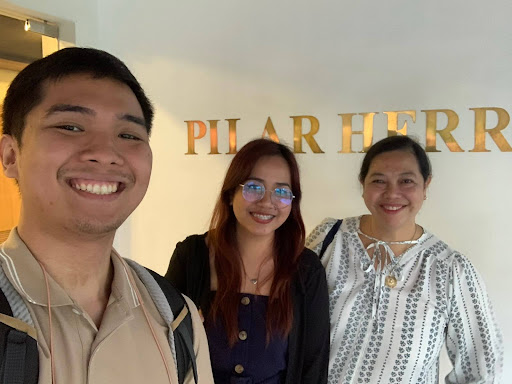Geography thrives at the intersection of places, people, communities, and landscapes they share—a scientific discipline rooted in understanding the connections that define the world we live in. Geographical studies provide a lens to explore the interplay between people and places by connecting theories with practices, and academic field activities (AFAs) bridge the gap by transforming these abstract concepts into tangible, lived experiences.
The International Conference on Geographical Studies 2024 Post-Conference, held on November 26 at the Pilar Herrera Hall, Palma Hall, University of the Philippines Diliman, is a manifestation that learning geography does not end in the classrooms. Organized as a post-conference, it showcased the fieldwork experiences of courses such as Geog 1 (Places and Landscapes in a Changing World), Geog 135 (Rural and Urban Geography), and Geog 197 (Digital Cartography).
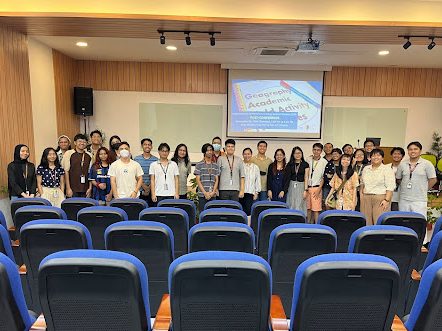
Philippine Geographical Society (PGS) President Asst. Prof. Emmanuel Garcia delivered his opening remarks and emphasized how AFAs serve as an “essential tool” in geographical studies by bringing a deeper understanding of the geographical theories learned inside the classroom.
“The motivation for this post-conference is for you to share your experiences in your AFAs kasi hindi naman lahat ng courses ay nakakapag-fieldwork nang ganito,” Department of Geography Assoc. Prof. Jake Rom Cadag added.

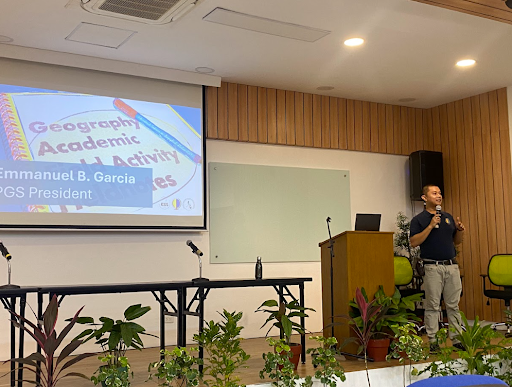
PGS President Asst. Prof. Emmanuel Garcia (left) and Assoc. Prof. Jake Rom Cadag (right) delivered their opening remarks and introduction for the post-conference.Photo credits: Asst. Prof. Fernand Francis M. Hermoso
Fostering unity in communities
Geog 1 (Places and Landscapes in a Changing World) AFA Presentation
Indeed, there is no “community” without “unity”—a statement that echoed through the Geog 1 presentation entitled “Reflexive Notes on the Sustainable Tourism Profiling of Pundaquit, San Antonio, Zambales.”
Led by Asst. Prof. Fernand Francis M. Hermoso and Mx. Nicholle Torres, the class explored the transformative impact of fieldwork on understanding and promoting sustainability within local communities like Brgy. Pundaquit.
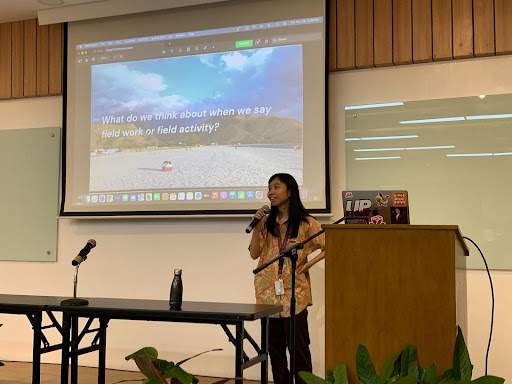
The discussion mainly revolved around “true sustainability”, defined as the balanced growth across economic, social, and environmental aspects which encompasses the Sustainable Tourism Framework. Mx. Torres underscored the importance of recognizing that the environment is not a separate entity but an integral part of the community.
“Something I would like to emphasize in our presentation here is that AFAs are not one-sided because we are working with a community. (…) We came there as collaborators, not saviors,” Mx. Torres added, emphasizing the mutual exchange of learning between students and residents of Brgy. Pundaquit.
Reflections from the Geog 1 class highlighted how empowering communities includes acknowledging and respecting their unique systems and own concepts of development.
As Mx. Torres concluded, “Important ang AFA para mas lalo tayong ma-ground and it gives an avenue to broaden our knowledge. Masasabi ko na after [the] AFA, mas naging engaged kami sa community at pati na rin ang pag-foster ng knowledge sa kapwa estudyante.”
The Geog 1 AFA presentation exemplified the power of collaboration in fostering sustainable development. By working alongside the community, the students proved that AFAs are not just an academic activity; instead, they are about engaging, learning, and collaborating with the people.
Amidst the bustling cities and railroads
Geog 135 (Rural and Urban Geography) AFA Presentation
Urban spaces are more than collections of buildings—they are living systems of commerce, heritage, and connectivity. This was the central theme of the Geog 135 presentation entitled “Varying Urbanities: Fieldnotes from Geog Stops throughout Metro Manila.”
Led by Assoc. Prof. Jake Rom Cadag, Mx. Luis Miguel Teran, and Mx. Rian Gio Maculado, the presentation unraveled Metro Manila’s diverse urban forms through “Geog stops” that the class explored. By traversing these urban spaces, they traced how cities, transportation, people, and their activities are intricately connected.
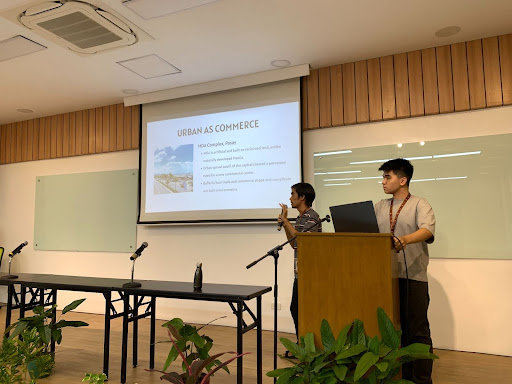
Such urban forms that were discussed include Urban as Commerce (Recto and MOA Complex), which showcased how commercial areas and economic activity serve as visible markers of urban development. They also discussed Urban as Transport Hub (Ayala and Cubao), highlighting the flow of human activity observed through foot traffic, commuter presence, and surrounding commercial establishments.
Lastly, the final Geog stop encapsulated Urban as Heritage in Pasig River Esplanade (PARES), Manila. The presenters emphasized the importance of preserving heritage, highlighting that urban spaces do not necessarily have to be about high-rise buildings—instead, they can be built on heritage and preserved in the memory of the city’s history.
Through these Geog stops, the team observed how urban design reflects both progress and challenges. Mx. Maculado shared, “These reflections won’t be possible without us being on ground. What we simply observed has led to a realization of what the city is and could be. Our part in greater conversations about urban concepts didn’t just come from the classroom, it also came from our experiences.”
Indeed, the Geog 135 presentation showcased the intricate links between urban life and the spaces that sustain it—transportation, heritage, commerce, and human activities. This offers a deeper understanding and new perspective on the dynamics of urban spaces within Metro Manila.
Mapping risks and resilience
Geog 197 (Digital Cartography) AFA Presentation
Maps are not just tools for navigation—they are lifelines in disaster preparedness and risk management, especially for vulnerable communities. This theme shaped the Geog 197 presentation, “Pagtukoy at Pagmapa ng mga Hazard at Peligro, Naranasang Kalamidad, at mga Hamon sa Pag-unlad,” which focused on disaster preparedness in Brgy. Tatalon, Quezon City.
Led by Asst. Prof. Ma. Simeona Martinez, Mx. Ceejay Abilay, Mx. Allyssa May Nuez, and Mx. Janica Kylle De Guzman, the presentation underscored how maps go beyond cartography to reflect the lived realities of vulnerable communities. The team illustrated the power of mapping as a tool for implementing risk reduction strategies and empowering residents to prepare for and respond to calamities.
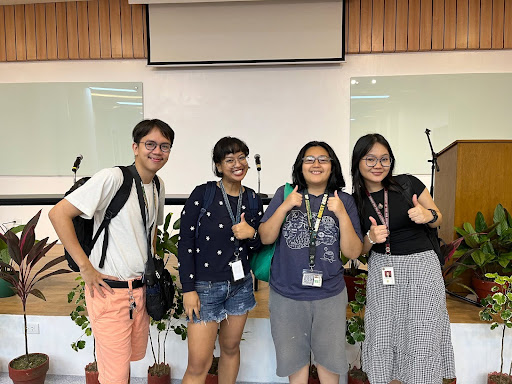
The discussion unfolded in three phases: conceptualization, fieldwork during the AFA, and post-AFA analysis. Each phase highlighted how maps serve as more than static visuals—they became dynamic tools for understanding risks and planning strategies that can save lives and livelihoods in Brgy. Tatalon.
“Hadlang ang kahirapan sa kahandaan sa sakuna, ngunit hindi nawawala ang pagkilala sa peligro at paghahanda dito,” Mx. Ceejay reflected, highlighting the resilience of the residents despite limited resources.
Beyond technical insights, the presenters emphasized the human element of fieldwork. “Madaling maging sympathetic sa ganitong mga bagay [but] it’s even harder to be empathetic. And to reach that kind of empathy, you have to experience their daily lives,” Mx. De Guzman reflected.
The Geog 197 team demonstrated how maps are more than geographic tools—they are instruments of resilience by fostering meaningful plans and strategies for disaster risk reduction.
The transformative power of AFAs in Geographical Studies
The International Conference on Geographical Studies 2024 Post-Conference showcased how geographical studies and field activities seamlessly connect theory with practice. This event emphasized the importance of learning beyond the classroom—AFAs serving as the bridge between abstract concepts and real-world applications.
From collaborating with communities to analyzing urban dynamics and addressing risks, the presentations showcased the diverse ways on how field activities bring geography to life.
The Office of Field Activities (OFA) Diliman is committed to enhancing the quality of experiential learning by advocating, promoting, and ensuring the safe conduct of academic field activities in UP Diliman and its constituent units. Led by OFA Diliman Director Asst. Prof. Arlyn P. Macapinlac, along with Senior Project Assistant for Training and Education Carlos Noel T. Gacutan and Staff Member Samantha Grace M. Delis, the OFA Diliman Team was honored to be invited to participate in the post-conference.
“AFAs play a significant part in the holistic education of our students, and OFA is your partner in safeguarding students during field activities,” Dir. Macapinlac remarked, encapsulating the importance of AFAs in shaping a well-rounded geographical education.
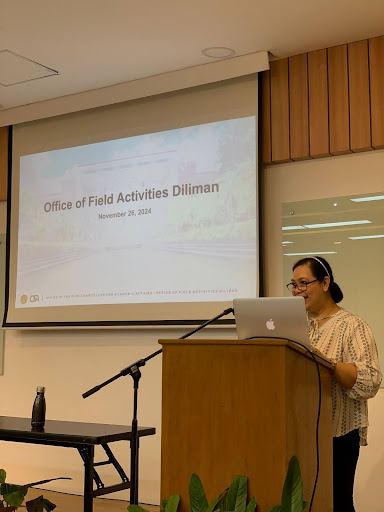
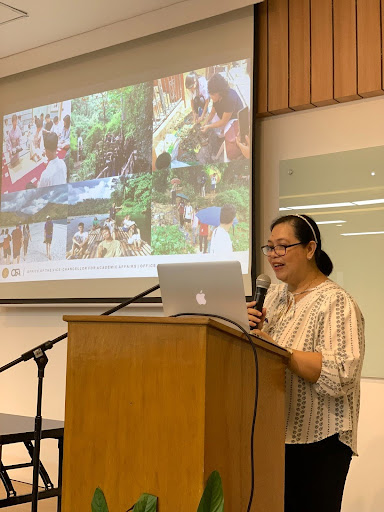
OFA Director Asst. Prof. Arlyn P. Macapinlac delivered her speech about OFA and AFAs for the post-conference.
In her message, Dir. Macapinlac also briefly discussed some pertinent information and reminders about AFAs and their implementation. She concluded her message with an invitation to AFA participants, students and teachers alike, to share their AFA experiences by submitting photo documentation and feature articles that will be showcased in the AFA Gallery and AFA Spotlight. In this way, they can build a partnership with OFA Diliman in promoting AFAs and inspiring students and teachers to appreciate the transformative role of AFAs in holistic education, while also providing a platform to showcase the enriching fieldwork experiences.
In every map drawn, connections made, and stories shared, this post-conference affirmed that AFAs are more than just academic activities—they are opportunities to engage with the real world and to humanize the lessons learned inside the classrooms.
